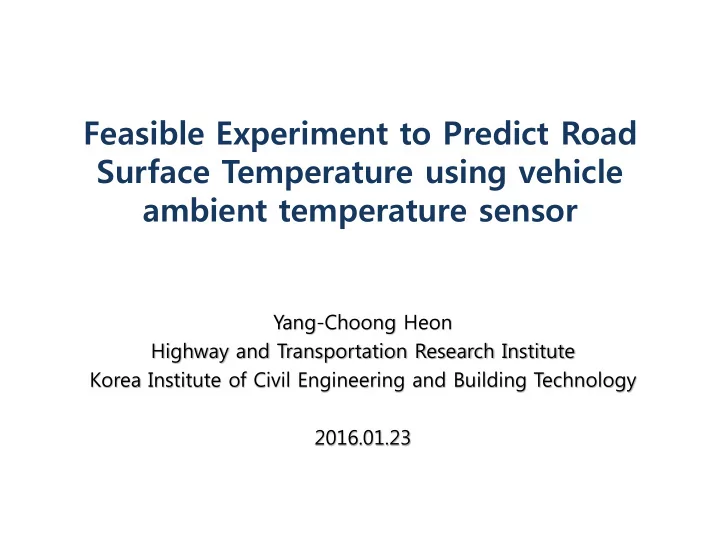

Feasible Experiment to Predict Road Surface Temperature using vehicle ambient temperature sensor Yang-Choong Heon Highway and Transportation Research Institute Korea Institute of Civil Engineering and Building Technology 2016.01.23
Why is it important? • Pattern of road temperature variation during winter is of huge significance in terms of traffic safety and operation. • What might be the most needed for road agencies is pattern of temperature variation in a specific road section. • Information can eventually help reduce risk of traffic accidents by suggesting safe driving in locations at high risk of road surface freezing or sections exposed to high possibility of black ice. 1
What we want to know? • Road surface temperature may show a substantially regular pattern of variation according to such spatial characteristics • This research identifies if temperature collected from vehicular ambient (VAT) sensors can comparably simulate pattern of road surface temperature variation in replacement of road surface temperature collected from a thermal mapping system. • We examined statistical significance of road surface temperature measured using a thermal mapping system and those collected from VAT sensor in the same section and time slot. 2
Data collection • The test route was selected considering different days, various weather and topographical conditions. • While it is assumed that altitude and topography in the test route is homogeneous. 25km (Two-way 50km) B Tunnel A 3
Data collection • The survey was conducted 10 times to each route on a round-trip basis all at the same time. • Vehicle kept the same speed (80km/hr) and travelled at the same lane (no lane change). • Weather conditions on the survey day were based on weather forecast information provided by KMA 4
Thermal mapping system and VAT • Thermal mapping system was employed to measure and collect road surface temperature. • This system was fully attached to a survey vehicle • VAT sensors were also attached in the front and rear of the survey vehicles, respectively. • Significant information such as temperature and humidity can be transmitted through USB. 5
Statistical analysis • A total of 1,100 data (A → B), 1,650 data (B →A) . 6
Statistical analysis • Correlation analysis was performed in order to identify if weather conditions classified according to survey date were consistent with actual weather conditions. • Pearson correlation coefficient was used. • When coefficient appears to above 0.3, then it indicates a correlation between two variables. 7
Statistical analysis 8
Road segmentation using surface road temperature • This study developed a way to divide road sections from the perspective of consecutive variation in road surface temperature for future application. • Basically, road sections are defines as number of sections in which individual temperature difference with average road surface temperature exceed 1.0 ℃. 9
Road segmentation using surface road temperature i + i + i 1 n Observed surface road Data Results temperature 1 5.1 Average 2 4.9 i 4.56 Average section 3 4.3 4 4.3 5 3.4 + i 1 6 3.1 3.2 section 7 3.1 8 6 + i 2 9 6.6 6.46 section 10 6.6 10
Road segmentation using surface road temperature • Road sections are divided based on final analysis of road surface temperature survey in the test route and its results are shown in table. 11
Similarity analysis between two temperatures • The analysis conducted a paired t-test to see if the difference between road surface and ambient temperature statistically significant. • Paired t-test is to compare average of two different sample groups but it can also be conducted to analyze significance of two different data collected and surveyed with different ways. 12
Similarity analysis between two temperatures • Alternative hypothesis assumes that “pattern of two temperature variations in same” should be adopted. • This means pattern of temperature variation collected from VAT sensor is statistically comparable 13
Conclusions and learning outcomes • This research was performed to analyze both reliability of road surface temperature collected from thermal mapping system. • Similarity between two temperatures in their patterns in same route and weather conditions using statistical technique. • It is logical that temperature from VAT sensor should be interpreted as valid temperature range rather than a precise value. 14
Conclusions and learning outcomes • It is possible to use in order to identify patterns of surface road temperature overall road sections if the collected temperature lies within ± 3℃ compared with actual one. • This information can be used so that general drivers and road agencies acquire critical benefits in terms of getting effective information on road, travelling ahead at minimum cost during the winter. • Finally, this study can serve as the preliminary finding to support such potential. 15
Recommend
More recommend